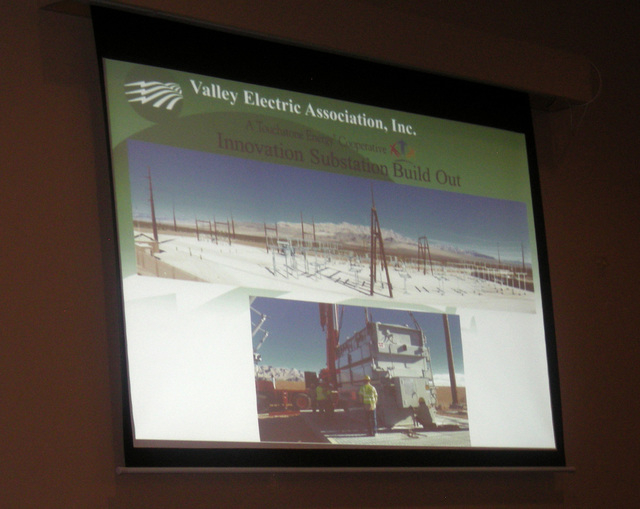
Valley Electric Association says it acted in good faith and didn’t yet place its Innovation Substation project at the Nevada National Security Site in commercial operation, so the cooperative shouldn’t be fined by the Public Utilities Commission.
VEA was awarded a five-year, $61.6 million contract to provide electricity to the Nevada National Security Site on Sept. 27, 2012, in response to a request for proposals from the U.S. Department of Energy. VEA offered to build a 5.3-mile, 138-kilovolt transmission line and infrastructure at the Mercury Switching Center to improve an existing transmission system more than 50 years old. It also provided fiber-optic cable.
The PUC general counsel said the 1963 agreement between VEA and Nevada Power Company, now part of NV Energy, required PUC approval to extend facilities within the NNSS, formerly known as the Nevada Test Site. The PUC claimed Valley Electric started construction on the Innovation Project Sept. 17, 2013, before commission approval 63 days later, subjecting VEA to fines of $1,000 per day or $63,000.
VEA countered the DOE maintains the extension of facilities in the 1963 agreement didn’t apply to reliability upgrades like the Innovation Project, that were located within the NNSS federal enclave.
VEA states it negotiated an interconnection agreement with Nevada Power and the DOE that defines ownership, switching and maintenance operations of electrical facilities at the NNSS, which will be filed with the Federal Energy Regulatory Commission when completed.
The Innovation Project won’t be placed into commercial operation until that interconnection agreement is approved by FERC and arrangements made with the California Independent System of Operators (CAISO), which the co-op expects to happen in June.
Valley Electric notes its long-standing animosity with Nevada Power dating back to the early 1960s with VEA’s predecessor, Amargosa Valley Cooperative. Nevada Power asked DOE to pay an exit fee as a condition of changing their contract to Valley Electric. But the PUC concluded last April the state law cited wasn’t applicable because the NNSS wasn’t in an exclusive service territory. Nevertheless, VEA said it requested PUC approval of the Innovation Project just in case in a petition filed July 12, 2013, or in the alternative, an order saying PUC approval wasn’t necessary.
The PUC issued an order Sept. 13, 2013 setting the Innovation Project case for hearings. VEA said it immediately began working with Nevada Power, PUC staff and the DOE, after Nevada Power expressed concern over possible impacts on the reliability of their system, but Nevada Power didn’t complain the 1963 agreement was breached.
VEA said it began construction Sept. 17, in order to meet a Nov. 1 contract completion date set by the DOE. An initial settlement was presented to the PUC Nov. 7 and an amended stipulation was filed Nov. 25, 2013. The parties agreed the project was in the public interest because it improved reliability of the NNSS and was critical to their national security mission. The PUC accepted the stipulation Dec. 20.
“When the parties stipulated, for the purpose of compromise, that the Innovation Project represented an extension of facilities, they did not agree that putting the inert, un-energized infrastructure in place, per DOE’s requirements, constituted an extension of facilities,” VEA said. “VEA has not placed the Innovation Project into commercial operation or operated the Innovation Project in parallel with VEA’s transmission line pending commission approval.”
The Nevada Supreme Court ruled in 1963 because of national security concerns, the DOE is allowed to acquire energy in any manner to carry out its sensitive mission at the NNSS, which was reaffirmed in 1998, Valley Electric states.
“In retrospect, VEA should have advised the commission regarding the need to move forward with the project in light of its contractual requirements, the co-op states. “At all times, VEA was working cooperatively and in good faith and fulfilled its commitment to refrain from putting the line in service and thereby extend its facilities within the NNSS. Further, VEA voluntarily filed a petition for approval despite the extensive legal precedent and DOE’s continuing belief that the 1963 agreement does not apply to reliability upgrades like the Innovation Project.”
In further stating its case, the co-op said: “As VEA explained to the hearing officer, VEA was obligated to install the poles and wires required by the DOE contract, but VEA committed that it would not make that equipment a part of its electrical system by putting them into commercial operation or operating them in parallel with its facilities unless and until the commission gave its approval.”
“The Innovation Project is still not used to provide electric energy within this state because, although the commission has approved it as in the public interest, the necessary FERC filings have not been completed. As of this filing, the NNSS is still served by precisely the same, insufficient facilities that were serving it on September 17, 2013 before VEA began to move ground on the Innovation Project,” VEA concludes.